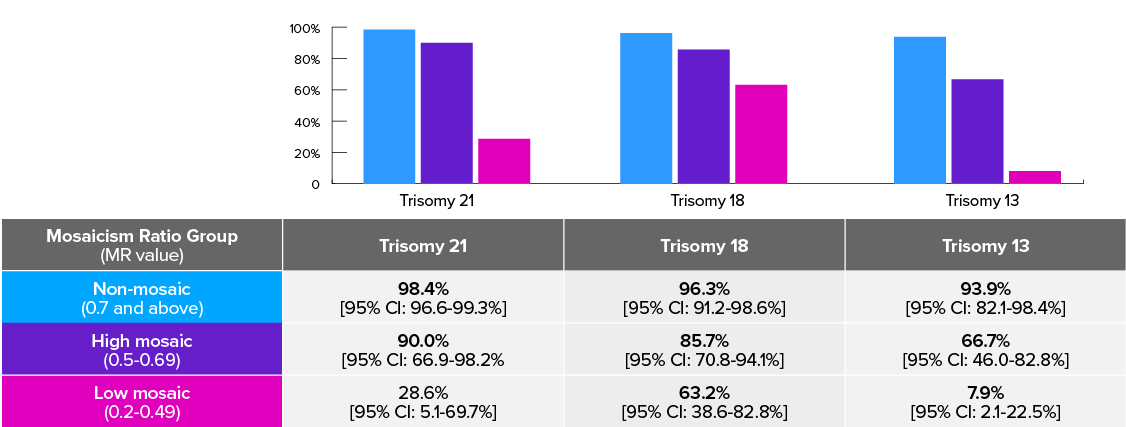- Patients Patients
Reproductive Genetics Testing
Patient Resources
Cost & Billing
- Providers Providers
- Genetic Counseling
- Login Login
- Estimate My Cost

Mosaicism Ratio
Personalized information for patients with positive NIPS (NIPT) results.
MaterniT 21 PLUS with Mosaicism RatioTM helps to refine your patient’s risk for aneuploidy using personalized data specific to their results.

Counseling patients with positive NIPS (NIPT)results can be complicated.
After nearly 10 years’ experience with NIPS (NIPT) testing, we know that not all positive results are created equal, and by definition screening tests may have the risk of a false-positive result.
The new Mosaicism Ratio result, only available with MaterniT 21 PLUS (at no extra cost), helps differentiate between a positive result that is more likely to be a true positive, and one with an increased chance to be a false positive.1
While most laboratories work hard to deliver the best possible results, experience, sequencing technology, and capability varies from lab to lab. Take advantage of our experience - Mosaicism Ratio adds an additional level of clarity. Rely on Integrated Genetics/LabCorp as your single-source laboratory partner for both best-in-class screening and follow-on diagnostic testing and ALL your needs across the entire pregnancy.
What is Mosaicism Ratio?
- A metric calculated in the event of a positive NIPS (NIPT) result for trisomy 21, 18, or 13
- Requires two data points:
- Affected fraction – the percentage of cell-free DNA that is impacted by aneuploidy
- Fetal fraction – the percentage of cell-free DNA contributed by the pregnancy

How is Mosaicism Ratio interpreted?
Positive results are classified into one of three Mosaicism Ratio groups:
| Groups | Likelihood of POSITIVE result being a TRUE POSITIVE |
|---|---|
| High mosaic | Positive NIPS (NIPT) result is more likely to be a true positive, associated with a higher PPV (see report below) |
| Low mosaic | Positive NIPS (NIPT) result is more likely to be a false positive, associated with a lower PPV (see report below) |
| Non-mosaic | Positive NIPS (NIPT) result that is very likely to be a true positive, associated with the highest PPV. No ‘mosaic’ language will display on the report. |
In general, as Mosaicism Ratio increases, so does the positive predictive value (PPV) of the result. The PPV associated with an individual patient result depends on the trisomy involved and the Mosaicism Ratio group associated with the results (i.e. nonmosaic, high mosaic, or low mosaic).
How is Mosaicism Ratio reported? (Singleton pregnancies only)
For patients with a positive result for trisomies 21, 18, and 13, a Mosaicism Ratio comment will feature in the Lab Director Comments box on the MaterniT 21 PLUS lab report.
| Test Result | Positive Trisomy 13 |
|---|---|
Lab Director Comments This specimen showed an increased representation of chromosome 13, suggestive of high mosaic trisomy 13, which may affect the reported PPV (Rafalko et al, 2020). In placental testing, trisomy 13 is a common finding that is often confined to the placenta (CPM), Grafi et al, 2014. However, true fetal involvement is associated with phenotypic abnormality. Genetic counseling, confirmatory diagnostic testing, and clinical correlation are recommended. | |
Test Result | Positive |
|---|---|
Lab Director Comments This specimen showed an increased representation of chromosome 18, suggestive of low mosaic trisomy 18, which may affect the reported PPV (Rafalko et al, 2020). In placental testing, trisomy 18 is a common finding that is often confined to the placenta (CPM), Grafi et al, 2014. However, true fetal involvement is associated with phenotypic abnormality. Genetic counseling, confirmatory diagnostic testing, and clinical correlation are recommended. | |
Positive Predictive Value (PPV) by trisomy and Mosaicism Ratio group

What are the potential causes of a low Mosaicism Ratio?
Though it may be difficult to pinpoint the exact cause of a low Mosaicism Ratio in any particular case, in general, a depressed Mosaicism Ratio may be the result of placental mosaicism, prior co-twin demise, or other biological phenomena.
Summary
- Mosaicism Ratio allows clinicians to provide customized counseling for patients with positive results for trisomy 21, 18, and 13 in singleton pregnancies
- The lower the mosaicism ratio, the greater the chance for a discordant result from diagnostic testing
- MaterniT 21 PLUS with Mosaicism Ratio identifies when a positive result is more likely to be a true positive
- Regardless of Mosaicism Ratio, diagnostic testing and genetic counseling are recommended for all positive NIPS (NIPT) results according to ACOG, Practice Bulletin 2262
| Test name | Test no. | Fetal sex opt-out |
|---|---|---|
| 451951 | ||
| 452112 | ||
| 452136 | ||
| 452122 | ||
| n/a | ||
| n/a | ||
| 452106 |
* Sex chromosome aneuploidies ** Enhanced sequencing series (microdeletions, trisomies 16 & 20)
Provider Login
Login to order tests for your patients. If you do not have an account, contact sales to get started.
Reference
- Rafalko et al. Impact of Mosaicism Ratio on positive predictive value of cfDNA screening. Prenatal Diagnosis, 2020.
- American College of Obstetricians and Gynecologists. Screening for Fetal Chromosomal Abnormalities. Practice bulletin no. 226. Obstet Gynecol. 2020;136(4):859-867


